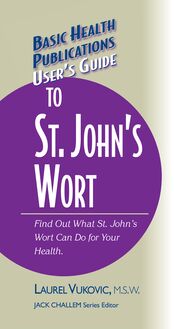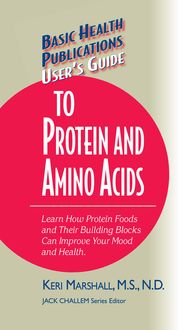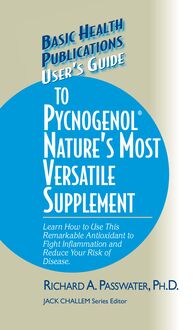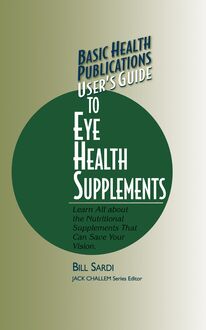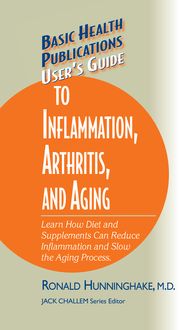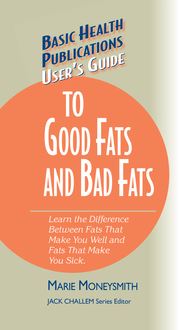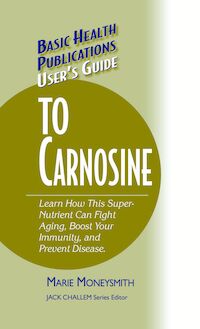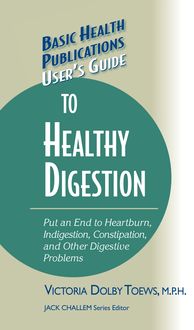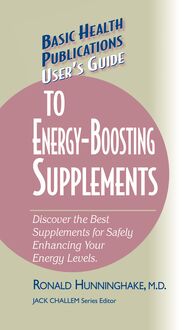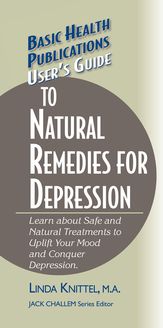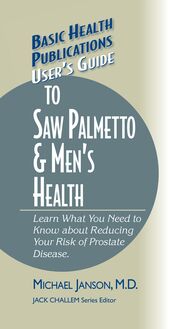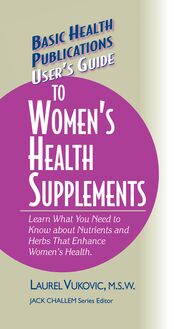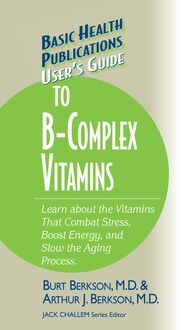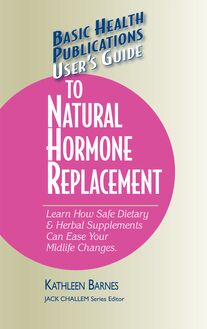User's Guide to Carotenoids & Flavonoids , livre ebook
47
pages
English
Ebooks
2005
Vous pourrez modifier la taille du texte de cet ouvrage
Obtenez un accès à la bibliothèque pour le consulter en ligne En savoir plus
Découvre YouScribe en t'inscrivant gratuitement
Découvre YouScribe en t'inscrivant gratuitement
47
pages
English
Ebooks
2005
Vous pourrez modifier la taille du texte de cet ouvrage
Obtenez un accès à la bibliothèque pour le consulter en ligne En savoir plus
Publié par
Date de parution
01 janvier 2005
Nombre de lectures
0
EAN13
9781591206798
Langue
English
Publié par
Date de parution
01 janvier 2005
Nombre de lectures
0
EAN13
9781591206798
Langue
English
The information contained in this book is based upon the research and personal and professional experiences of the authors. It is not intended as a substitute for consulting with your physician or other healthcare provider. Any attempt to diagnose and treat an illness should be done under the direction of a healthcare professional.
The publisher does not advocate the use of any particular healthcare protocol but believes the information in this book should be available to the public. The publisher and authors are not responsible for any adverse effects or consequences resulting from the use of the suggestions, preparations, or procedures discussed in this book. Should the reader have any questions concerning the appropriateness of any procedures or preparations mentioned, the authors and the publisher strongly suggest consulting a professional healthcare advisor.
Series Editor: Jack Challem
Editor: Laura Jorstad
Typesetter: Gary A. Rosenberg
Series Cover Designer: Mike Stromberg
Basic Health Publications User’s Guides are published by Basic Health Publications, Inc.
8200 Boulevard East
North Bergen, NJ 07047
1-800-575-8890
Copyright © 2004 by Jack Challem and Marie Moneysmith
ISBN: 978-1-59120-679-8
All rights reserved. No part of this publication may be reproduced, stored in a retrieval system, or transmitted, in any form or by any means, electronic, mechanical, photocopying, recording, or otherwise, without the prior written consent of the copyright owner.
Printed in the United States of America
10 9 8 7 6 5 4 3 2 1
C ONTENTS
Introduction
1. The Power of Plants: Carotenoids and Flavonoids
2. Carotenoids Close Up
3. Alpha-Carotene, Astaxanthin, and Cryptoxanthin
4. Focus on Flavonoids
5. More Flavonoid Favorites
6. The Diet Dilemma: Food versus Supplements
7. Buying and Using Carotenoids and Flavonoids
8. On the Horizon
Conclusion
Selected References
Other Books and Resources
I NTRODUCTION
I n recent years, the phrase eat plenty of fruits and vegetables has become a mainstay in the world of nutrition and health. By now, most people know these foods are highly recommended, but they may not be sure exactly why. To complicate matters, health experts are also encouraging us to eat plenty of different-colored produce, although again, the reasoning behind the recommendation may not be quite clear.
None of this advice is new. Mothers have been telling children to “eat a lot of color” for decades. But today, scientists can explain why eating a wide variety of colorful fruits and vegetables is good for health. These foods are rich sources of—among other things—health-promoting plant compounds known as phytochemicals. There are thousands of different phytochemicals in the plant world. Scientists have isolated and studied many of them, and so far, some of the most potent fall into two categories: carotenoids and flavonoids.
Carotenoids are plant pigments that have vitamin-like properties. And although their name may suggest they are only found in carrots, that’s not the case at all. These colorful nutrients provide the orange, yellow, red, purple, and other colors of many fruits and vegetables. At the same time, they promote good health and reduce the risk of disease.
You may have heard of some of the better-known carotenoids, such as beta-carotene, lutein, and lycopene. During the past twenty years, scientists have conducted hundreds of studies on these important substances. Research has shown, for example, that carotenoids are powerful antioxidants, much like vitamins C and E, with the ability to minimize the damage done by rogue molecules known as free radicals, and to protect against such common ailments as heart disease, cancer, diabetes, Alzheimer’s disease, chronic fatigue syndrome, and vision problems.
Carotenoids work both independently and together, enhancing one another’s effectiveness. And they are remarkably versatile. Some carotenoids, for example, can be converted by our bodies to vitamin A when more of this nutrient is needed. Other carotenoids have specific disease-fighting abilities. Beta-carotene, for example, is a powerful stimulant of immune cells that protects against infections and certain types of cancer. Lutein can reduce the risk of developing macular degeneration, a leading cause of blindness. And lycopene may help prevent prostate, stomach, and lung cancer.
Flavonoids are another large family of phytochemicals. The largest subgroup of a family of plant compounds known as polyphenols, flavonoids are compounds found not only in fruits and vegetables but in tea, nuts, beans, herbs, legumes, and grains, as well. Some flavonoids, including the soybean-derived genistein and EGCG (epigallocatechin gallate) from green tea, have made headlines. With its weak resemblance to the hormone estrogen, genistein is shaping up as a useful supplement for women suffering from menopause discomforts. And EGCG is being hailed for its cancer-fighting and weight-loss qualities. But there are a number of other, equally powerful flavonoids that can benefit your health in a wide variety of ways.
With healthcare and prescription drug costs surging upward, it’s encouraging to know that Mother Nature has provided us with a veritable arsenal against disease in the form of these phytochemicals. The problem is that the Standard American Diet (with the appropriate acronym SAD ) is woefully lacking in carotenoids and flavonoids. Trade in the typical burger, with its wilted iceberg lettuce and unripened tomato slice, for a real salad and you’ve taken a healthy step toward an entirely new you. The more processed baked goods, fast food, and snack products you can exchange for “real” food—fruits, vegetables, grains, and nuts—the more carotenoids and flavonoids you’ll be getting. Incorporating more carotenoids and flavonoids into your meals isn’t difficult, because they are so abundant in nature. And once you understand the benefits bestowed on your health by these potent substances, you’ll want to seek out these foods.
Although we’ve been led to believe that the real benefit of fruits and vegetables is in their vitamin C content, that’s not really accurate. Most of the antioxidant power in these and other whole foods comes from carotenoids and flavonoids, the unsung heroes of good health. There are thousands of these compounds in fruits and vegetables, some working together, others operating in slightly different ways. And scientists are discovering that one or two antioxidants are not enough to protect us against disease. Instead, our bodies seem to thrive when we consume many different antioxidants, like those found in a diet focused on a variety of fruits, vegetables, and other whole foods.
In addition to providing your body with the building blocks of good health, there’s one more area where carotenoids and flavonoids excel—weight management. No, they’re not a magic bullet that will make pounds disappear. But a diet high in these substances definitely falls into the low-carbohydrate, high-fiber category. Better yet, the carbs in these foods are primarily complex, the very kind that provide the slow, steady supply of energy essential for blood sugar and hunger management. Add some high-quality protein to the mix and you’ve got the makings of a solid weight-loss plan.
In the following pages, we’ll look at the foremost carotenoids and flavonoids, as well as some that are considered up-and-coming, and learn more about recent scientific research showing how these substances can keep us healthy. We’ll also explore both sides of the ongoing debate over food versus supplements, and examine ways to increase intake of carotenoids and flavonoids. In the end, you’ll know how these vital substances enrich your health and why. More important, you’ll be able to identify the everyday foods with the greatest health benefits. Whether you want to improve your overall health, treat a specific condition, or just maintain the status quo, carotenoids and flavonoids can help support your goal.
CHAPTER 1
T HE P OWER OF P LANTS : C AROTENOIDS AND F LAVONOIDS
N ot so long ago, human beings evolved eating a diet rich in plant foods, including berries, roots, and shoots that we would probably not even recognize today. In fact, our current Standard American Diet is very limited in terms of plant foods. We concentrate on the commonplace—potatoes, iceberg lettuce, tomatoes, orange juice—and ignore anything unusual. As a result, we miss out on a wide variety of tastes and textures, as well as an incredible array of nutrients that nature provides.
All of this makes sense when you understand that carotenoids and flavonoids play an important role in nature—they provide protection for plants and animals. Sunlight is necessary for plants to grow. However, ultraviolet (UV) wavelengths can generate dangerous molecules called free radicals, which injure living cells. Free radicals oxidize cells much the same way they turn iron to rust or make butter go rancid. Many carotenoids and flavonoids function as antioxidants, which means they protect against free radicals. In other words, carotenoids and flavonoids are a plant’s defense against free radicals, and they also protect plant genes, which direct the behavior of cells. And when we eat these substances, we receive the same overall health benefits. Like vitamins, carotenoids and flavonoids play many other roles in health, such as enhancing the immune system, your defense against infection; preventing damage to deoxyribonucleic acid (DNA, the molecule that carries our genetic information); and reducing the risk of cancer and heart disease.
Basically, carotenoids are pigments, the substances that make carrots orange, corn yellow, and tomatoes red, as well giving salmon, shrimp, and flamingos their vivid hues. Many flavonoids are pigments, too, although some provide flavor, as their name suggests. They are just as powerful and essential to

